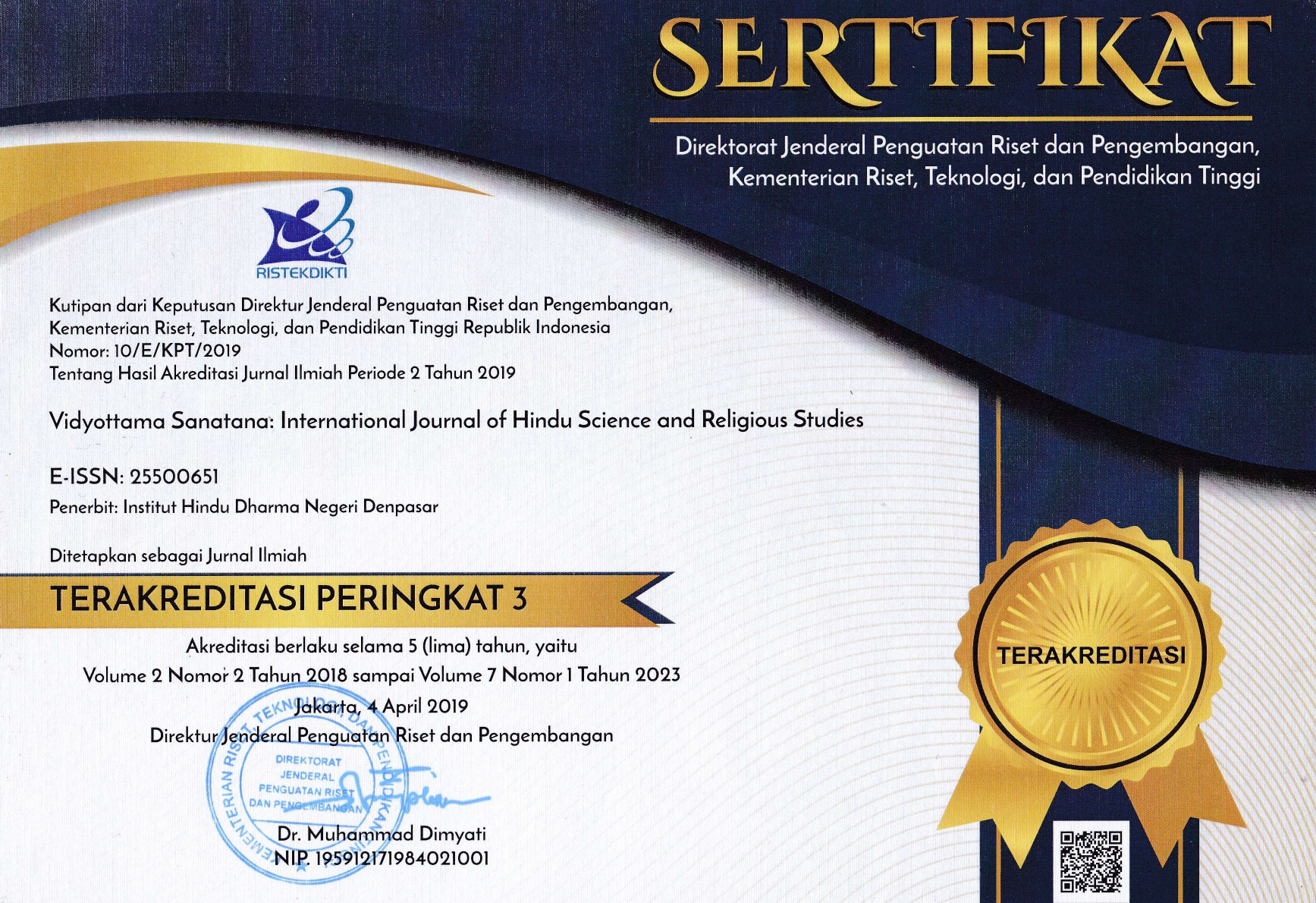A MATHEMATICAL STUDY IN HISTORICAL PERSPECTIVE ON EARLY CHRONOGRAMS FROM CAMBODIA, VIETNAM AND INDONESIA
DOI:
https://doi.org/10.25078/vidyottama.v7i2.2480Keywords:
aṅkānāṃ vāmato gatiḥ, bhūtasaṅkhyā, chronogram, and sengkala.Abstract
With four objectives, this paper conducts a mathematical study on the early chronograms from Cambodia, Vietnam and Indonesia in a historical perspective. First, the history and terminology of word-symbols from India to Southeast Asia is explored. This paper finds that the terms used for word-symbol in India are component-oriented while the term sengkala coined in Indonesia is application-oriented. Second, the reasons why the early chronogram-words have acquired the numerical-values they represent have been explored. Third, an insight is provided that the move, whether sinistral or dextral, used for writing word-symbol notation in India and chronogram in Southeast Asia had nothing to do with the maxim aṅkānāṃ vāmato gatiḥ. Fourth, two points from the paper written by Apsari, Sariyasa, Junaidi, Tyaningsih and Gunawan are commented on. This paper suggests that the mathematical ideas employed in writing the chronograms be recognized as a history of mathematics. It acknowledges that the use of chronograms can make the teaching of mathematics culturally relevant.
References
Acharya, S. K. 2001. Numerals in Orissan Inscriptions. Shimla: IIAS.
Annisa. 2011. Penggunaan kronogram di Indonesia, Vietnam, dan Kamboja Abad VII-XIV M: Pendekatan arkeologis dan epigrafis. Tesis. Depok, Jakarta: Fakultas Ilmu Pengetahuan Budaya, Program Studi Magister Arkeologi, Universitas Indonesia.
Apsari, R. A.; Sariyasa, S.; Junaidi, J.; Tyaningsih, R. Y. & G. Gunawan. 2021. An Ethnomathematics Case Study of Candrasengkala: A reversed order chronogram in Bali-Java tradition. Journal of Physics: Conference Series 1933: 1-7.
Apte, V. S. 1893. The Student’s English-Sanskrit Dictionary. Bombay: Published by Mrs. R. A. Sagoon.
Bratakesawa, R. & Hadisoeprapta, T. W. K. 1980. Keterangan Candrasengkala. Jakarta: Department Pendidikan dan Kebudayaan.
Bosch, F. D. K. 1941. Een Maleische Inscriptie in het Buitenzorgsche. Journal of the Humanities and Social Sciences of Southeast Asia, 49-53.
Barth, M. A. 1885. Inscriptions Sanscrites du Cambodga. Paris: Imprimerie Nationale.
Bhargava, M. L. 1964. The Geography of Ṛgvedic India. Lucknow: The Upper India Publishing House Ltd.
Cappeller, C. 1891. Sanskrit-English Dictionary. Strassburg.
Caturvedī, M. (ed.). 1998. Siddhānta-śiromaṇi of Bhāskara II (with his autocommentary & Vārttika of Nṛsiṃha Daivajña). Varanasi: Sampurnanand Sanskrit University.
Chhabra, B. Ch. 1965. Expansion of Indo-Aryan Culture during Pallava Rule. Delhi: MRML Oriental Publishers.
Cœdés, G. 1943-1946. Quelques précisions sur la fin du Fou-nan. Bulletin de l'Ecole Française d'Extrême-Orient.Tome XLIII (Hanoi): 1-8.
Cœdés, G. 1954. Inscriptions du Cambodge, Vol. VI. Paris: EFEO.
Diller, A. 1996. New Zeros and old Khmer. Mon-Khmer Studies Journal 25: 125-132.
D’Ambrosio, U. 1985. Ethnomathematics and its place in the history and pedagogy of mathematics. For the Learning of Mathematics 5(1): 44-48.
Datta, B. B. & Singh, A. N. 1935. History of Hindu Mathematics, Part I. Lahore: Motilal Banarsidass.
Dravid, G. K. (compiler). 1914. Samayocitapadyamālikā. Bombay: Tukaram Javaji.
Dvivedin, S. (ed.). 1902. Brāhmasphuṭasiddhānta and Dhyānagrahopadeśā-dhyāya by Brahmagupta. Benares.
Dvivedin, S. (ed.). 1995. Mahāsiddhānta of Āryabhaṭa II. Delhi: Chaukhamba Sanskrit Pratishthna.
Egner, D. W. 1920. English Javanese Vocabulary. Hollandsch-Amerikaansche Plantage Mij.
Golzio, Karl-Heinz. 2000. Considerations on the chronology and history of 9th century Cambodia. Siksācakr Nº 2: 21-25.
Golzio, Karl-Heinz (ed.). 2004. Inscriptions of Campā based on the editions and translations of Abel Bergaigne, Étienne Aymonier, Louis Finot, Édouard Huber and other French scholars and of the work of R. C. Majumdar. Aachen: Shaker Verlag.
González-Reimann, L. 1989. The ancient Vedic dice game and the names of the four world ages in Hinduism. In: World Archaeoastronomy (ed. A. F. Aveni), pp. 195-202. Cambridge: Cambridge University Press.
Gupta, R. C. 2011. Kali Chronograms of Nārāyaṇa Bhaṭṭatiri (15th-17th centuries AD). Indian Journal of History of Science 46(3): 517-521.
Harshananda, S. 2008. A Concise Encyclopaedia of Hinduism, 3 Vols. Banglore: Ramakrishna Math.
Jacquet, E. 1835 (Juillet). Mode d’expression symbolique des nombres employé par les Indiens, les Tibétains et les Javanais. Nouveau Journal asiatique 16: 5-42 and 97-130.
Jadhav, D. 1998a. Nemicandrācāryakṛta granthoṃ meṃ akṣara-saṃkhyāoṃ kā prayoga. Arhat Vacana 10(2): 47-59.
Jadhav, D. 1998b. Saṅkhyā sāta kā vaidika mahatva. Rasaraṅga (Sunday supplement of daily Indian Hindi newspaper Dainika Bhāskara, August 30), 3.
Jadhav, D. 2017. The Jaina School of Indian Mathematics. Indian Journal of History of Science, 52.3: 316–334.
Jadhav, D. 2018. On the word-numerals referred to in the Vyavahāra-gaṇita of Rājāditya. Arhat Vacana 30.4: 53-73.
Jadhav, D. 2019. On word-numerals in Nāgavarma’s Canarese Prosody. International Journal of Jaina Studies 15.3: 1-21.
Jadhav, D. 2023. Object-numerals as listed in Nijaguṇa Śivayogī’s Viveka-Cintāmaṇi. Indian Journal of History of Science.
Jaini, J. L. (ed. & tr.). 1927. Gommaṭasāra (Jîvakāṇḍa) of Nemicandra. Lucknow: The Central Jaina Publishing House.
Kapadia, H. R. (ed.). 1937. Gaṇitatilaka of Śrīpati. Baroda: Oriental Institute.
Kaye, G. R. 1915. Indian Mathematics. Calcutta: Thacker, Spink and Co.
Kern, H. 1917. Verspreide-Geschriften. ʼs-Gravenhage, M. Nijhoff.
Limaye, M. S. 2019. The use of bhūta-saṅkhyās in the Līlāvatī of Bhāskarācārya. In: Bhāskarā-prabhā (eds. K. Ramasubramanian et al.), pp. 392-406. Delhi: Hindustan Book Agency.
Listya, A. & Pratama, D. 2019. Sengkalan memet: A chronogram visualized by Javanese through many stages of symbolizations. IICACS Vol. 1 (2019): 34-42.
Lochtefeld, J. G. 2002. The Illustrated Encyclopedia of Hinduism. New York: The Rosen Publishing Group.
Mahārāja, Sāgarānanda Sūri. (ed.). Vikrama Saṃvat 2038 (= 1980/1981). Āvaśyakaniryukti (with Haribhadra Sūri’s commentary), Part I. Mumbai: Bherulāla Kanaiyālāla Koṭhārī Dhārmika Trust.
Majumdar, R. C. 1927. Ancient Indian Colonies in the far East, Vol. I: Champa. Lahore: The Punjab Sanskrit Book Depot.
Majumdar, R. C. 1953. Inscriptions of Kambuja. Calcutta: The Asiatic Scociety.
Mak, B. M. 2013. The date and nature of Sphujidhvaja’s Yavanajātaka reconsidered in the light of some newly discovered materials. History of Science in South Asia 1: 1-20.
Mani, V. 1975. Purāṇic Encyclopaedia. Delhi: Motilal Banarsidass.
Mukhtara, R. C. Jain & Patni, C. P. (eds.). 1975. Trilokasāra of Nemicandra (with Sanskrit and Hindi commentary). Srimahaviraji.
Neugebauer, O. & Pingree, D. (eds. & trs.). 1970. The Pañcasiddhāntikā of Varāhamihira, Part I. Kopenhagen.
Noorduyn, J. 1993. Some remarks on Javanese chronogram words: A case of localization. Bijdragen tot de Taal-, Land- en Volkenkunde 149(2): 298-317.
Petit, J. 2009. Eugène Jacquet and his pioneering study of Indian numerical notations. Gaṇita Bhāratī 31(1-2): 27-37.
Pigeaud, T. G. Th. 1960. Java in the 14th Century: The Nāgara-Kĕrtāgama by Rakawi Prapañca of Majapahit, 1365 A.D; Vol. I: Javanese texts in transcription and Vol. III: Translations. The Hague: Martinus Nijhoff.
Pigeaud, T. G. Th. 1963. Java in the 14th Century: The Nāgara-Kĕrtāgama by Rakawi Prapañca of Majapahit, 1365 A.D; Vol. V: Glossary, General Index. Springer-Science+Business Media, B.V.
Pingree, D. 1981. Jyotiḥśāstra: Astral and Mathematical Literature. Wiesbaden.
Plofker, K. 2009. Mathematics in India. Princeton and Oxford: Princeton University Press.
Prabowo, A.; Sugandha, A. & Tripena Br. Sb, A. 2016. Suryasengkala Lamba: The Indonesian-Javanese Chronogram. Global Journal of Pure and Applied Mathematics 12.6: 5079-5085.
Princep, J. 1834. Professor Schlegel’s enigma - Mode of expressing numerals in Sanskrit and Tibetan languages. Journal of the Asiatic Society of Bengal 3: 1-8.
Pandit, M. D. (ed. & tr.). 1992. Līlāvatī of Bhāskarācārya, Part I. Pune: S. M. Pandit.
Pandit, M. D. 1993. Mathematics as known to the Vedic Saṃhitās. Delhi: Sri Satguru Publications.
Ramesh, K. V. & Tewari, S. P. 1975-76. An inscription of Pratihāra Vatsarāja, Śaka 717. Epigraphia Indica 41: 49-57.
Rangacharya, M. (ed. & tr.). 1912. Gaṇita-sāra-saṅgraha of Mahāvīrācārya. Madras: The Government of Madras.
Rooney, A. 2013. The History of Mathematics. New York: The Rosen Publishing Group, Inc.
SaKHYa (ed. & tr.). 2009. Gaṇitasārakaumudī of Ṭhakkura Pherū. New Delhi: Manohar Publishers.
Sarma, K. V. 2003. Word and alphabetic numerical systems in India. In: The Concept of Śūnya (eds. Bag & Sarma), 37-71. New Delhi: IGNCA, INSA and Aryan Books International.
Sarma, S. R. 2009. On the rationale of the maxim aṅkānāṃ vāmato gatiḥ. Gaṇita Bhāratī 31(1-2): 65-86.
Sarma, S. R. 2012. The kaṭapayādi system of numerical notation and its spread outside Kerala. Revue d’histoire des mathématiques 18: 37-66.
Sarma, S. R. 2021. Who is the native of the Sarvasiddhāntatattvacūḍāmaṇi? History of Science in South Asia 9: 167-208.
Śāstrī, Pt. H. (ed.). 1998. Amarakoṣa of Amarasiṃha. Varanasi: Chowkhamba Sanskrit Series Office.
Schlegel, A. W. 1832. Réflexions sur l’étude des langues asiatiques. Bonn. Especially see Explication d’une Enigme, pp. 197-199.
Shellabear, W. G. 1912. Malay-English Vocabulary. Singapore: The Methodist Publishing House.
Shukla, K. S. (ed.). 1986. Vaṭeśvara-Siddhānta and Gola of Vaṭeśvara, Part I. New Delhi: Indian National Science Academy.
Shylaja, B. S. & Javagal, S. (trs.). 2021. Gaṇitagannaḍi. Bengaluru: Navakarnataka.
Sircar, D. C. 1965. Indian Epigraphy. Delhi: Motilal Banarsidass.
Taylor, McComas (tr.). 2021. The Viṣṇu Purāṇa: Ancient Annals of the God with Lotus Eyes. ANU Press.
Teeuw, A. 1998. An old Jvanese poem on chronogram words. In: Productivity and Creativity (eds. Mark Janse et al.), pp. 369-392. Berlin: Mouton de Gruyter.
Vidyanath, R. (ed. & tr.). 2013. Illustrated Aṣṭāṅga Hṛdaya of Vāgbhaṭa: Sūtra-Sthāna. Varanasi: Chaukhamba Surbharati Prakashan.
Wijayatno, W. 2003. Sengkalan: Mystery of words and forms. The Jakarta Post (Daily English Indonesian Newspaper, March 30). https://jawawa.id/newsitem/ sengkalan-mystery-of-words-and-forms-1447893297
Wolters, O. W. 1982. History, Culture, and Region in Southeast Asian Perspectives. Singapore: Institute of Southeast Asian Studies.


















